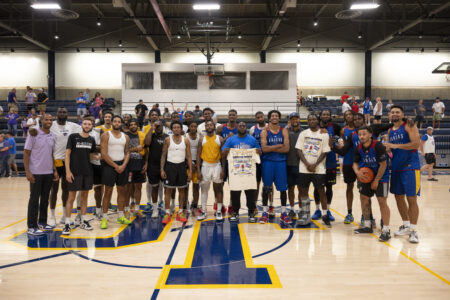Woodling: Locale, fame factors in coverage away from arenas
Those of us who buy ink by the barrel are prone to label stories of monumental importance as either the Second Coming or World War III. Or both.
Basically, these blockbuster news stories are read word-for-word by everyone, usually because the words recount a horrifying disaster or because they involve something unusual about someone famous.
J.R. Giddens is famous. He is a starter on Kansas University’s men’s basketball team, and around here, you can’t acquire fame any faster.
When every game you play is on live television, you are an instant celebrity. Everything you do occurs inside a fishbowl. You walk into a grocery store and people will whisper, “Look, it’s J.R. Giddens.” Later, people will tell their friends, “Guess who I saw at the store yesterday? J.R. Giddens.”
A decade from now, when people talk about J.R. Giddens, the Pavlovian reaction will be the stabbing incident. Even if he becomes an All-American, a first-round NBA Draft choice or even the governor of Oklahoma, Giddens forever will be tied to the Moon Bar melee.
At least around these parts. After all, it did happen here.
Now let’s talk about former KU basketball All-American Paul Pierce. What’s your first reaction to Pierce?
Let’s see : Left after his junior year for the NBA. Slipped to the 10th selection in the NBA Draft. Became an all-star. Plays for the Celtics. Uh, came to KU from the Los Angeles area. That’s about it.
What about the time Pierce was knifed? Oh, yeah, forgot about that. But that didn’t happen here. It happened in Boston.
Exactly. The geography factor at work. What happens here remains indelibly here. What happens there soon is forgotten.
By the way, to refresh your memory, the Pierce stabbing makes Gidden’s leg wound look like a paper cut.
On Sept. 25, 2000, Pierce was attacked inside a Boston nightclub. He was stabbed eight times in addition to being clubbed in the head with a bottle of champagne and pummeled by a dozen patrons who jumped into the mix.
Doctors saved the former Jayhawk’s life when he suffered severe stab wounds to his face, neck and back, including one that damaged his lung and abdomen. Two and a half years later, Pierce showed his gratitude by pledging $2.5 million to help expand the hospital’s surgery center.
Imagine the media circus if Pierce had been stabbed in Lawrence or Topeka or Kansas City while he still was at Kansas University. As it was, we read about the Pierce incident in Boston with fascination, but not with the same focus we would have if he had been assaulted in a nearby watering hole.
In a similar vein, would you be surprised if I told you a Kansas University football player was shot outside a Lawrence bar 15 years ago?
Over the years, you’ve read stories about June Henley shoplifting, Mario Kinsey and Reggie Duncan stealing a purse and John Randle brawling, but the KU football player who was shot wasn’t a skill player, and so that story quietly has faded away.
The player’s name was Khristopher Booth. He was a red-shirt freshman offensive lineman and he was shot in the chest by a Fort Riley solider wielding a small-caliber handgun during an argument outside the now defunct Pizzaz nightclub at 901 Miss.
Remarkably, Booth suffered only minor injuries, and that’s another reason the incident didn’t generate more publicity. When it comes to injuries, publicity is generated in direct proportion to the seriousness.
Also relegating the incident to obscurity was the fact Booth never became a player with name recognition. In fact, coach Glen Mason kicked him off the team prior to the 1992 Aloha Bowl. Booth later transferred to Central State in Ohio and disappeared from the Kansas consciousness.
Yet, Booth and Giddens are, in my memory, the only KU athletes who ever have been wounded in bar incidents while they still were enrolled. Neither was hurt seriously – thank goodness – but it’s a case study in fame. One became a Second Coming and the other barely a second thought.







